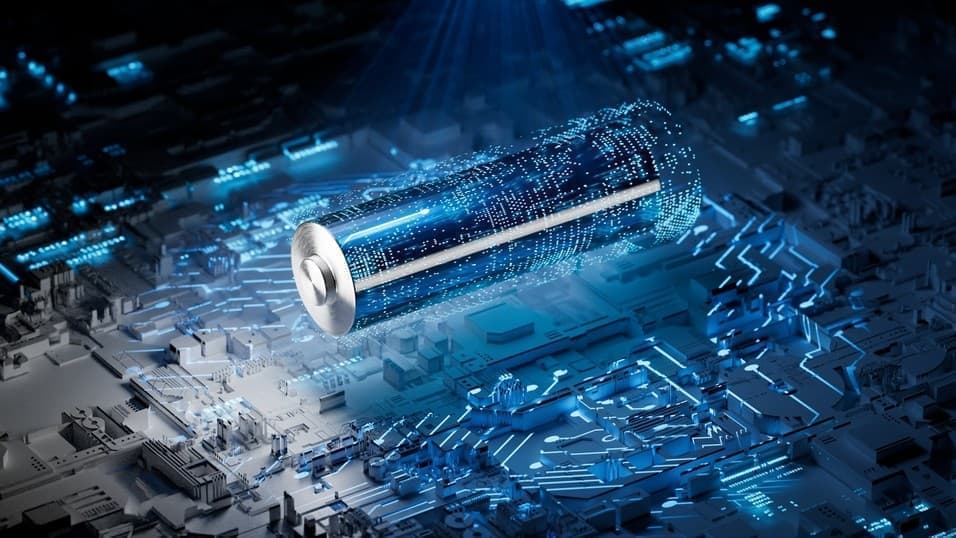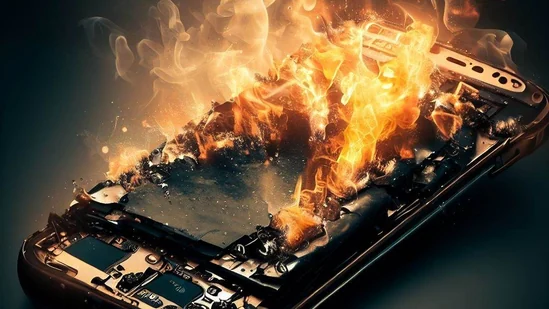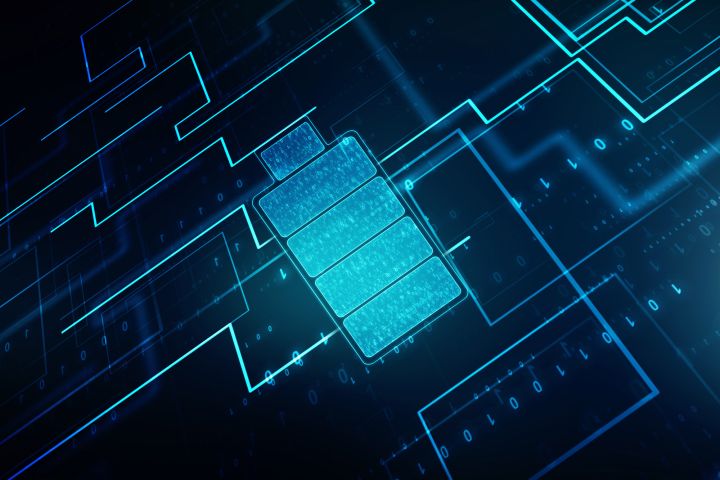Lithium is the smallest and most reactive metal in the periodic table. Its small size is favored for its high capacity density, making it popular among consumers and engineers. However, its highly reactive chemical properties also pose significant risks. Lithium metal, when exposed to air, can undergo a vigorous oxidation reaction with oxygen, leading to an explosion. To enhance safety and voltage, scientists have invented the use of materials such as graphite and lithium cobalt oxide to store lithium atoms. The molecular structure of these materials forms nano-sized storage lattices that can accommodate lithium atoms. This design ensures that even if the battery casing is ruptured and oxygen enters, the large oxygen molecules cannot penetrate these tiny storage lattices, preventing contact between lithium atoms and oxygen, thus averting an explosion. This principle of lithium-ion batteries allows for high capacity density while achieving safety.
During the charging of lithium-ion batteries, lithium atoms at the positive electrode lose electrons and are oxidized into lithium ions. These lithium ions travel through the electrolyte to the negative electrode, enter the storage lattice there, and gain an electron, being reduced back to lithium atoms. The process is reversed during discharge. To prevent direct contact and short-circuiting between the positive and negative electrodes, a separator with many fine pores is added inside the battery to prevent short circuits. A good separator can also automatically close these pores when the battery temperature becomes too high, preventing the lithium ions from passing through and thus rendering the battery harmless to prevent dangerous incidents.

When the battery cell is overcharged to a voltage higher than 4.2V, side reactions begin to occur. The higher the overcharge voltage, the greater the danger. Once the lithium battery cell voltage exceeds 4.2V, the number of lithium atoms remaining in the positive electrode material is less than half, and the storage lattices often collapse, leading to permanent capacity loss. If charging continues, since the storage lattices at the negative electrode are already full of lithium atoms, subsequent lithium metal will accumulate on the surface of the negative electrode material. These lithium atoms will grow dendritic crystals from the negative electrode surface towards the direction of the lithium ions. These lithium metal dendrites can pierce the separator, causing a short circuit between the positive and negative electrodes. Sometimes, the battery may explode before the short circuit occurs because, during the overcharging process, the electrolyte and other materials can decompose and generate gases, causing the battery casing or pressure valve to bulge and rupture, allowing oxygen to enter and react with the lithium atoms accumulated on the negative electrode surface, leading to an explosion. Therefore, when charging lithium-ion batteries, it is essential to set an upper voltage limit to ensure the longevity, capacity, and safety of the battery. The ideal maximum charging voltage is 4.2V.
There should also be a lower voltage limit when discharging lithium cells. When the cell voltage drops below 2.4V, some materials begin to be damaged. Since batteries have self-discharge, the longer they are discharged, the lower the voltage will be, so it is best not to discharge to 2.4V before stopping. During the discharge of lithium-ion batteries from 3.0V to 2.4V, the energy released accounts for only about 3% of the battery's capacity. Therefore, 3.0V is an ideal cut-off voltage for discharge.
In addition to voltage limitations, current limitations are also necessary during charging and discharging. When the current is too high, lithium ions cannot enter the storage lattices in time and accumulate on the surface of the material. After these lithium ions gain electrons, lithium atom crystals appear on the material surface, similar to overcharging, which can be dangerous. If the battery casing is ruptured, an explosion may occur.
Therefore, protection for lithium-ion batteries should include at least three aspects: an upper limit for charging voltage, a lower limit for discharging voltage, and an upper limit for current. Generally, in addition to the lithium-ion battery cell, a protection circuit board is included in a lithium-ion battery pack to provide these three protections. However, these three protections from the protection board are clearly not enough, as lithium-ion battery explosion incidents continue to occur worldwide. To ensure the safety of the battery system, a more careful analysis of the causes of battery explosions is necessary.

1.Significant internal polarization!
2.Electrode tabs absorb moisture, reacting with the electrolyte to cause swelling.
3.Issues with the quality and performance of the electrolyte itself.
4.The amount of electrolyte added during the filling process does not meet the required specifications.
5.Poor sealing performance of the laser welding during the assembly process, resulting in leaks and failure to detect leaks.
6.Dust particles, which can first lead to micro-short circuits for unknown reasons.
7.The positive and negative electrode tabs are thicker than the process specifications, making it difficult to insert them into the casing.
8.Problems with the sealing of the electrolyte filling hole, where the sealing performance of the steel ball is not good, leading to swelling.
9.Variations in the thickness of the casing material supplied, which can affect the thickness and cause deformation of the casing.
The types of battery cell explosions can be summarized into three categories: external short circuits, internal short circuits, and overcharging. The term "external" here refers to outside the battery cell, including short circuits caused by poor insulation design within the battery pack.
When an external short circuit occurs and the electronic components fail to interrupt the circuit, the battery cell will experience high internal heat, causing some of the electrolyte to vaporize and expand the battery casing. When the internal temperature of the battery reaches 135 degrees Celsius, a high-quality separator will close the pores, stopping or nearly stopping the electrochemical reactions, causing a sudden drop in current and a gradual decrease in temperature, thus preventing an explosion. However, if the pore closure rate is too low or the pores do not close at all, the battery temperature will continue to rise, more electrolyte will vaporize, and eventually, the battery casing will rupture, potentially leading to a combustion and explosion of the materials.
Internal short circuits are primarily caused by copper and aluminum foil whiskers piercing through the separator or by lithium metal dendrites piercing through the separator. These tiny metallic needles can cause micro-short circuits. Since the needles are thin and have a certain resistance value, the current may not be very high. Copper and aluminum foil whiskers are caused during the production process and can be detected by the battery cell manufacturers or assembly plants as the batteries leak too quickly. Moreover, due to the fineness of the whiskers, they may sometimes be burned off, allowing the battery to return to normal. Therefore, the probability of an explosion caused by whisker micro-short circuits is not high.
This statement is statistically supported by the fact that there are often defective batteries with low voltage shortly after charging in various battery cell factories, yet there are very few explosion incidents. Therefore, explosions caused by internal short circuits are mainly due to overcharging. After overcharging, the electrode is covered with needle-like lithium metal crystals, causing micro-short circuits everywhere. As a result, the battery temperature gradually increases, and eventually, the high temperature vaporizes the electrolyte gas. In this situation, whether it is the high temperature causing the materials to burn and explode or the casing being ruptured first, allowing air to enter and react violently with the lithium metal, the outcome is an explosion.
However, this type of explosion caused by overcharging and internal short circuits does not necessarily occur during charging. It is possible that the battery temperature has not yet risen to the point of causing the materials to burn, and the gases produced are not enough to rupture the battery casing when the consumer stops charging and takes the phone out. At this time, the heat generated by the numerous micro-short circuits slowly increases the battery temperature, and after a period, an explosion occurs. The common description from consumers is that they noticed the phone was very hot when they picked it up, and it exploded after being thrown away.
Integrating the above types of explosions, we can focus on preventing overcharging, preventing external short circuits, and enhancing the safety of the battery cells. Preventing overcharging and external short circuits are related to electronic protection and are closely related to the design and assembly of the battery system. Enhancing the safety of the battery cells focuses on chemical and mechanical protection, which is closely related to the battery cell manufacturing factory.

Given the billions of mobile phones globally, to achieve safety, the failure rate of safety protection must be less than one in a hundred million. Since the failure rate of circuit boards is generally much higher than one in a hundred million, the battery system design must have more than two safety lines of defense. A common mistake in design is to charge the battery pack directly with a charger (adaptor). This places the entire responsibility for overcharging protection on the protection board of the battery pack. Although the failure rate of the protection board is not high, even if it is as low as one in a hundred thousand, statistically there would still be explosion accidents occurring every day worldwide.
If the battery system provides two lines of safety protection for overcharging, over-discharging, and overcurrent, and the failure rate of each line of defense is one in ten thousand, then two lines of defense can reduce the failure rate to one in a hundred million. A common battery charging system block diagram is as follows, including two major parts: the charger and the battery pack. The charger consists of an adaptor and a charging controller. The adaptor converts alternating current to direct current, while the charging controller limits the maximum current and voltage of the direct current. The battery pack includes a protection board and battery cells, as well as a PTC (Positive Temperature Coefficient) device to limit the maximum current.
Taking the mobile phone battery system as an example, the first line of defense against overcharging is achieved by setting the output voltage of the charger to around 4.2V. This means that even if the protection board on the battery pack fails, the battery will not be overcharged and will not pose a danger. The second line of defense is the overcharge protection function on the protection board, generally set to 4.3V. This means that the protection board usually does not need to cut off the charging current, only acting when the charger voltage is abnormally high. Overcurrent protection is the responsibility of the protection board and a fuse, which also provides two lines of defense to prevent overcurrent and external short circuits. Since over-discharge only occurs during the use of electronic products, the first line of defense is generally provided by the product's circuit board, with the protection board on the battery pack providing the second line of defense. When the electronic product detects a supply voltage lower than 3.0V, it should shut down automatically. If the product was not designed with this feature, the protection board will cut off the discharge circuit when the voltage drops to 2.4V.
In summary, when designing a battery system, it is essential to provide two lines of electronic protection against overcharging, over-discharging, and overcurrent. The protection board is the second line of defense. If the battery explodes after removing the protection board during charging, it indicates poor design.
Although the above method provides two lines of protection, consumers often buy non-original chargers to charge their devices after the original charger fails. Charger manufacturers, considering cost, often omit the charging controller to reduce costs. As a result, many inferior chargers have flooded the market, which undermines the first and most crucial line of defense against overcharging. Overcharging is the most significant factor in causing battery explosions, so inferior chargers can be considered the main culprit in battery explosion incidents.
In some cases, the battery pack may also include a charging controller. For example, many laptop computer external battery bars have a charging controller. This is because laptops typically integrate the charging controller into the computer itself, providing only an adaptor to the user. Therefore, the external battery pack for laptops must have a charging controller to ensure safety when charging with an adaptor. Additionally, products that charge using a car cigarette lighter sometimes incorporate the charging controller into the battery pack.
If all electronic protective measures fail, the final line of defense must be provided by the battery cell itself. The safety level of the battery cell can be roughly distinguished by its ability to withstand external short circuits and overcharging. Since, before a battery explodes, if there are lithium atoms accumulated on the surface of the materials internally, the explosive power will be greater. Moreover, the protection against overcharging is often reduced to only one line of defense due to consumers using inferior chargers. Therefore, the battery cell's ability to resist overcharging is more important than its ability to resist external short circuits.




The lab focuses on solid-state battery research to overcome traditional lithium batteries' safety and energy density issues, supporting environmental sustainability. It develops innovative solid-state electrolytes, refines electrode materials, and investigates ion transfer and interface stability to revolutionize battery technology.

The electric vehicle battery industry is rapidly developing, focusing on technological innovation, market competition, and sustainability. Research hotspots include solid-state batteries, new types of electrolytes, BMS optimization, and recycling technologies. The environmental adaptability, safety, and economic viability of batteries are key research areas, and the industry is expected to undergo more innovation and transformation.

Specializing in battery preparation technology research, the focus is on overcoming existing energy storage challenges by innovating in electrode materials, battery chemistry, and manufacturing processes to improve performance, safety, and reduce costs. Sustainability and recycling technologies for batteries are also emphasized to mitigate environmental impacts and foster the growth of green energy.